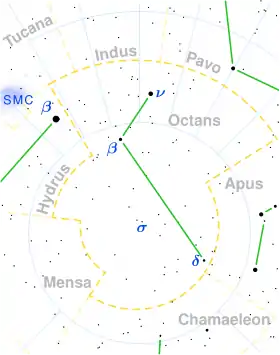Epsilon Octantis
Epsilon Octantis, Latinized from ε Octantis, is a star in the southern circumpolar constellation of Octans. It is a faintly visible to the naked eye with an apparent visual magnitude of 5.09.[2] The annual parallax shift of 11.22[1] mas yields a distance estimate of around 291 light years. It is moving further from the Sun with a radial velocity of +11.7 km/s.[6]
| Observation data Epoch J2000 Equinox J2000 | |
|---|---|
| Constellation | Octans |
| Right ascension | 22h 20m 01.67970s[1] |
| Declination | −80° 26′ 23.0947″[1] |
| Apparent magnitude (V) | 5.09[2] |
| Characteristics | |
| Spectral type | M5III[3] |
| U−B color index | +1.18[4] |
| B−V color index | +1.47[4] |
| Variable type | SRb[5] |
| Astrometry | |
| Radial velocity (Rv) | +11.70[6] km/s |
| Proper motion (μ) | RA: +56.81[1] mas/yr Dec.: −43.47[1] mas/yr |
| Parallax (π) | 11.22 ± 0.23[1] mas |
| Distance | 291 ± 6 ly (89 ± 2 pc) |
| Absolute magnitude (MV) | 0.34[2] |
| Details | |
| Mass | 1.34[7] M☉ |
| Radius | 112±15[8] R☉ |
| Luminosity | 1,819[8] L☉ |
| Surface gravity (log g) | 2.15[7] cgs |
| Temperature | 3,560±264[8] K |
| Other designations | |
| Database references | |
| SIMBAD | data |
This is an evolved, cool red giant star with a stellar classification of class M5III.[3] It is a semiregular variable with a magnitude range of 4.58 to 5.3 and a (poorly defined) period around 55 days.[5] The star has 1.34[7] times the mass of the Sun and has expanded to around 112[8] times the Sun's radius. It is radiating 1,819[8] times the Sun's luminosity from its enlarged photosphere at an effective temperature of 3,560 K.[8]
References
- Van Leeuwen, F. (2007). "Validation of the new Hipparcos reduction". Astronomy and Astrophysics. 474 (2): 653–664. arXiv:0708.1752. Bibcode:2007A&A...474..653V. doi:10.1051/0004-6361:20078357. S2CID 18759600. Vizier catalog entry
- Anderson, E.; Francis, Ch. (2012). "XHIP: An extended hipparcos compilation". Astronomy Letters. 38 (5): 331. arXiv:1108.4971. Bibcode:2012AstL...38..331A. doi:10.1134/S1063773712050015. S2CID 119257644. Vizier catalog entry
- Hoffleit, D.; Warren, W. H. (1995). "VizieR Online Data Catalog: Bright Star Catalogue, 5th Revised Ed. (Hoffleit+, 1991)". VizieR On-line Data Catalog: V/50. Originally Published in: 1964BS....C......0H. 5050. Bibcode:1995yCat.5050....0H.
- Mermilliod, J. C. (2006). "VizieR Online Data Catalog: Homogeneous Means in the UBV System (Mermilliod 1991)". VizieR On-line Data Catalog: II/168. Originally Published in: Institut d'Astronomie. 2168. Bibcode:2006yCat.2168....0M.Vizier catalog entry
- Samus, N. N.; Durlevich, O. V.; et al. (2009). "VizieR Online Data Catalog: General Catalogue of Variable Stars (Samus+ 2007-2013)". VizieR On-line Data Catalog: B/GCVS. Originally Published in: 2009yCat....102025S. 1. Bibcode:2009yCat....1.2025S.
- Gontcharov, G. A. (2006). "Pulkovo Compilation of Radial Velocities for 35 495 Hipparcos stars in a common system". Astronomy Letters. 32 (11): 759–771. arXiv:1606.08053. Bibcode:2006AstL...32..759G. doi:10.1134/S1063773706110065. S2CID 119231169.
- Allende Prieto, C.; Lambert, D. L. (1999). "Fundamental parameters of nearby stars from the comparison with evolutionary calculations: Masses, radii and effective temperatures". Astronomy and Astrophysics. 352: 555–562. arXiv:astro-ph/9911002. Bibcode:1999A&A...352..555A. Vizier catalog entry
- Arroyo-Torres, B.; et al. (June 2014), "VLTI/AMBER observations of cold giant stars: atmospheric structures and fundamental parameters", Astronomy & Astrophysics, 566: 11, arXiv:1404.7384, Bibcode:2014A&A...566A..88A, doi:10.1051/0004-6361/201323264, S2CID 16778588, A88
